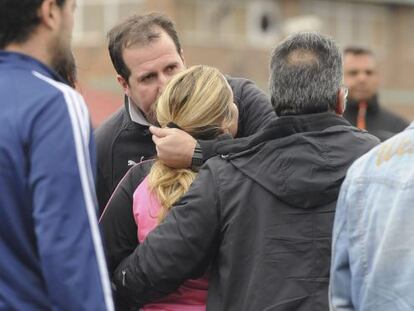"I got nervous. When there is gas in the mine, it is hard to stay calm"
A survivor of an underground blast reflects on last month's tragic accident in León

There was an explosion, then silence. "Is everybody there? Who's missing? The darkness is so impenetrable and there's so much dust that you can't find your colleagues even if you're shoulder to shoulder."
On Monday of last week, Alfredo relived the horror that he personally experienced on Christmas Eve of 2006. When he heard that six colleagues in a León mine had died from a gas leak, it unlocked his own memories of firedamp — a term used for various flammable gases found in pockets inside coal mines. There are only two differences between the 2006 and 2013 accidents: first, one was an explosion and the other a leak. Second, Alfredo and his team survived, while last month's victims did not.
"Some of us still had our helmets on, others didn't. One was completely disoriented, walking toward the fire," recalls Alfredo (an assumed name), who is in early retirement at 51 and still has nightmares that see him wake up in a cold sweat.
Something threw me five or six meters away from where I was standing"
"A boss told me, 'Fifty years from now you'll still be this way," he explains in a resigned tone.
Seasoned miners say that when you've been doing this long enough, you can detect firedamp, whose chief component is methane gas. "You feel this pressure in your temples, like a headache coming on," he says.
But Alfredo and his four colleagues had no time to feel any kind of pain: the blast caught them off guard as they were digging a water outlet deep inside the earth. They were in the pit known as Aurelio del Valle, some three kilometers from the spot of last month's deadly accident. As a matter of fact, the underground galleries are connected. But perhaps that is not surprising in a region where every mountain and every valley have been transformed with picks and shovels and the sweat of entire generations of mining families.
Alfredo, a miner with 28 years' experience, was working 50 meters from a source of heat that the rescue brigade had been meaning to seal up. Suddenly, "something" blew up.
"All I remember is that something threw me five of six meters away from where I was standing. It must have been a major blast," he says, pointing at his robust, nearly two-meter frame.
A silent return to the coalface
After a week of inactivity following the death of six miners from a gas leak, around 100 of their colleagues went back to work Wednesday at Pozo Emilio del Valle (León province) in complete silence, with bowed heads and tearful faces. "After what happened, people are downcast, the absences are missed," said Eric Rodríguez, one of the workers.
Before the shift started, an assembly was held in tribute to the deceased companions. The area where the accident occurred will remain closed until technicians from the Regional Mining Commission determine the cause of the incident.
"Going back was heartrending; nobody opened their lips. It was like reliving everything all over again," said José Antonio Colinas, a miner and representative of the UGT labor union. The miners that went back to work included four of the five men who were hurt by the gas leak but survived. These individuals have been assigned outdoor duties. A fifth survivor remains hospitalized in León, although he is out of intensive care. A security committee inspected the facilities with the miners before walking each one to his place of work. "It was a gesture to make them feel less alone on the first day," said Colinas.
That something was a pocket of firedamp that was released following a sudden subsidence of the rock. Nobody knows for sure what happened, but a joint investigation by the mine operator Hullera-Vasco Leonesa, the company union and Castilla y León regional government, concluded that the most likely explanation was a collapse that liberated a large amount of firedamp, which exploded on contact with the source of heat. The blast consumed much of the gas; also, the miners were standing near the main gallery, which had clean air. "As it was an explosion, we instinctively ran in the other direction, which [last week's] colleagues couldn't do because the firedamp killed them without warning," says Alfredo.
Asked to recount his fight for survival inside an underground maze, in complete darkness and surrounded by poisonous gases, Alfredo says that it's something one has to go through in order to understand it. "Some took out their rescue kit and others..." — there is a pause as his gaze turns inward - "...well, we just ran in best 'save-your-own-skin' style. I hightailed it out of there, dragging my helmet behind me, and no, I didn't use the rescue kit."
The kit he is referring to is a tool weighing a kilogram that miners wear around their waist and use to protect themselves against the inhalation of firedamp or other toxic gases.
"I got nervous, and that is where the danger lies," he explains, saying it also applies to October's accident at Pozo Emilio del Valle. "If one of them had kept calm, they might still be alive, but at times like those it is hard to stay calm."
Alfredo and his four colleagues felt their way forward and, with trembling fingers, found the monorail used to shuttle material around inside the mine. The sound of the turbines guided them along, ultimately saving their lives. They stumbled out into the open air, a group of dirty, bruised, half-asphyxiated men with pieces of coal sticking out of their backs and their adrenaline levels sky-high. "You feel so nervous, so giddy... if they asked you at that point to ram your head through a wall and go out the other side, you would happily break it down with your head."
If one of them had kept calm, they might still be alive, but at times like those it is hard to stay calm"
The thing is, Alfredo and his colleagues should not have been working in that gallery. Only a middle manager knew that they were down there — the same person who had ordered them to create an outlet for the water accumulating there. That is why Ramón, the site manager, ran like a madman to find them as soon as he was informed that five of his men were at the very spot where the explosion had been registered.
They walked out of the mine without help, and made their way to the hospital that the mine operator, Hullera Vasco-Leonesa, runs in the nearby municipality of Santa Lucía. Alfredo lost his voice for eight months because the firedamp burnt his vocal chords, but that very same night he dined with his family as though nothing had happened. To this day, his mother does not know that he was on the brink of death.
He did not want to ask for sick leave, so on January 7 he went back to work. "After a night without sleep, you start getting visits. All of my colleagues came to see me: my bosses, the site managers, the engineer, even the deputy director."
But the fear remained. Even today, there is still fear in his eyes when he talks about it. "I am not going back in there; there's no way," he told his boss. And indeed he never went back to the gallery where he had the accident, nor to any of the nearby ones. He never got any trouble over it. The next two years — his last ones before going into early retirement — Alfredo felt like a king at the mine. Even when he left a half-hour early to watch a soccer match, nobody said a thing. But he resented the way they insisted on downplaying the accident. "The bosses said we were very lucky because nothing had happened. I think they wanted us to tone down what we were going to say in the report for the company and the union."
These days, Alfredo spends his time visiting family members and friends, and going to watch his beloved Real Madrid at Santiago Bernabéu stadium. When accidents like last month's make the news, the memories come flooding back, but as he puts it: "You think you could be dead, too. You value life a lot more, and you develop an equilibrium. That's the good part about having such a bad thing happen to you."
Tu suscripción se está usando en otro dispositivo
¿Quieres añadir otro usuario a tu suscripción?
Si continúas leyendo en este dispositivo, no se podrá leer en el otro.
FlechaTu suscripción se está usando en otro dispositivo y solo puedes acceder a EL PAÍS desde un dispositivo a la vez.
Si quieres compartir tu cuenta, cambia tu suscripción a la modalidad Premium, así podrás añadir otro usuario. Cada uno accederá con su propia cuenta de email, lo que os permitirá personalizar vuestra experiencia en EL PAÍS.
¿Tienes una suscripción de empresa? Accede aquí para contratar más cuentas.
En el caso de no saber quién está usando tu cuenta, te recomendamos cambiar tu contraseña aquí.
Si decides continuar compartiendo tu cuenta, este mensaje se mostrará en tu dispositivo y en el de la otra persona que está usando tu cuenta de forma indefinida, afectando a tu experiencia de lectura. Puedes consultar aquí los términos y condiciones de la suscripción digital.
More information
Últimas noticias
The complicated life of Francesca Albanese: A rising figure in Italy but barred from every bank by Trump’s sanctions
Half of Scotland is in the hands of 420 property owners
Reinhard Genzel, Nobel laureate in physics: ‘One-minute videos will never give you the truth’
Pinochet’s victims grapple with José Antonio Kast’s rise in Chile
Most viewed
- Pablo Escobar’s hippos: A serious environmental problem, 40 years on
- Why we lost the habit of sleeping in two segments and how that changed our sense of time
- Charles Dubouloz, mountaineering star, retires at 36 with a farewell tour inspired by Walter Bonatti
- Reinhard Genzel, Nobel laureate in physics: ‘One-minute videos will never give you the truth’
- The Florida Keys tourist paradise is besieged by immigration agents: ‘We’ve never seen anything like this’











































